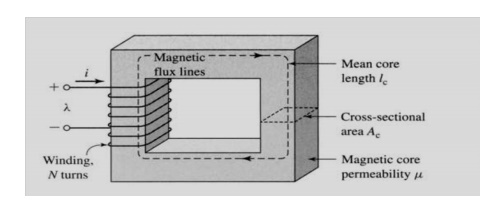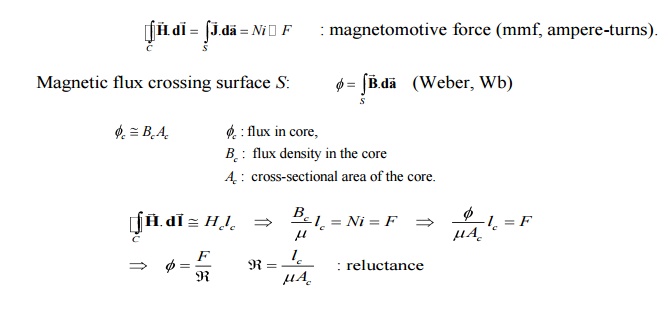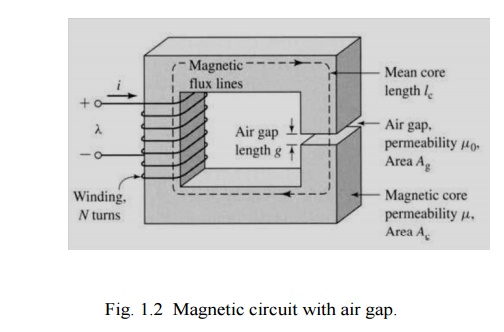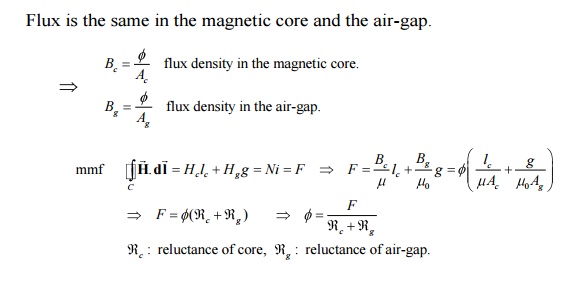Chapter: Electrical machines : Magnetic Circuits and Magnetic Materials
Magnetic Circuits and Magnetic Materials
MAGNETIC CIRCUITS AND MAGNETIC MATERIALS
Introduction
The law of conservation of energy states that the energy cannot be related or destroyed but it can be converted from one form to other. An electrical energy does not occur naturally and also cannot be stored. Hence the efforts are made to generate it continuously to meet the large demands. But to generate an electrical energy means to convert some other form of energy into an electrical form, according to law of conservation of energy. A commonly used method to generate an electrical energy is converting mechanical energy into electrical with the help of a rotating device. Such a machine which converts the mechanical energy into an electrical energy is called a generator. The input mechanical energy can be achieved from steam turbines, steam engines or using potential energy of water to run hydraulic turbines. Such a device which inputs a mechanical energy to a generator is called a prime mover. While converting energy from mechanical to electrical form, some losses take place. The losses are kept to minimum value by properly designing the machine. Practically the efficiencies of large generators are above 90 %
Magnetic Circuits
In a magnetic circuit, the magnetic lines of force leaves the north poles passes through the entire circuit and return the starting point. A magnetic circuit usually consist of materials having high permeability such as iron , soft steel etc., These materials offer very small opposition to the flow of magnetic flux . consider a coil of N turns would on an iron core

Ampere’s law





magnetism plays an important role in electricity. Electrical appliances like Generator, Motor, Measuring instruments and Transformer are based on the electromagnetic principle and also the important components of Television, Radio and Aero plane are working on the same principle.
1. Magnetic Material
Magnetic materials are classified based on the property called permeability as
1. Dia Magnetic Materials
2. Para Magnetic Materials
3. Ferro Magnetic Materials
1. Dia Magnetic Materials
The materials whose permeability is below unity are called Dia magnetic materials. They are repelled by magnet.
Ex. Lead, gold, copper, glass, mercury
2. Para Magnetic Materials
The materials with permeability above unity are called Para magnetic materials. The force of attraction by a magnet towards these materials is low.
Ex.: Copper Sulphate, Oxygen, Platinum, Aluminum.
3. Ferro Magnetic Materials
The materials with permeability thousands of times more than that of paramagnetic materials are called Ferro magnetic materials. They are very much attracted by the magnet.
Ex. Iron, Cobalt, Nickel.
Permanent Magnet
Permanent magnet means, the magnetic materials which will retain the magnetic property at a] l times permanently. This type of magnets is manufactured by aluminum, nickel, iron, cobalt steel (ALNICO).
To make a permanent magnet a coil is wound over a magnetic material and DC supply is passed through the coil.
Electro Magnet
Insulated wire wound on a bobbin in many turns and layers in which current is flowing and a soft iron piece placed in the bobbin is called electromagnet.

This is used in all electrical machines, transformers, electric bells. It is also used in a machine used by doctors to pull out iron filing from eyes, etc.
2. Magnetic Effect By Electric Current
If current passes through a conductor magnetic field is set up around the conductor. The quantity of the magnetic field is proportion to the current. The direction of the magnetic field is found by right hand rule or max well's corkscrew rule. Magnetic Flux The magnetic flux in a magnetic circuit is equal to the total number of lines existing on the cross-section of the magnetic core at right angle to the direction of the flux.
H=N/l AT/m
B = mH
B=m0mrNI / l Wb/m2
ϕ =F/S
S=l/m0mra
Φ - total flux
N - number of turns
I - current in amperes
S – reluctance
µ - permeability of free space
µ0 - relative permeability
a - magnetic path cross-sectional area in m2
l - lengh of magnetic path in metres
Related Topics